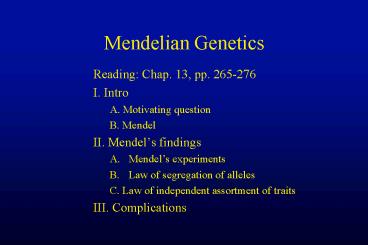Mendelian Genetics PowerPoint PPT Presentation
1 / 35
Title: Mendelian Genetics
1
Mendelian Genetics
- Reading Chap. 13, pp. 265-276
- I. Intro
- A. Motivating question
- B. Mendel
- II. Mendels findings
- Mendels experiments
- Law of segregation of alleles
- C. Law of independent assortment of traits
- III. Complications
2
Terms and Concepts
- character, trait, alleles, locus
- - homozygous/heterozygous
- - phenotype/genotype
- - P, F1, F2
- - dominant/recessive
- - law of segregation
- - law of independent assortment
- - Testcross
- - Rules of probability
- Incomplete dominance
- codominance
- Quantitative characteristics
3
What Darwin didnt know
- How did heritability work?
- What exactly was passed down from parents to
offspring? - Blending vs. particulate?
- No idea about Genes, chromosomes, DNA, mitosis
and meiosis
4
Gregor Mendel
Austrian contemporary of Darwin Published shortly
after Darwin - but work was buried
Fig 22.1
5
Who was Mendel?
- - Austrian monk
- - Background in agriculture (grew up on a farm)
- - Failed his teachers exam
- - University of Vienna math, causes of variation
in plants - - Teaching at the Brünn Modern School
6
What did he do?
- Pea breeding
- Testing mechanisms of inheritance blending vs.
acquired characteristics (e.g., Lamarck) - Used many different characters
- Published results in 1865
7
Mendel didnt know about chromosomes either!
- Results were buried for 40 years not broadly
accepted until 16 years after his death. - Early in the 20th century, Sutton and Boveri
(working independently) formulated the chromosome
theory of inheritance, which proposes that
meiosis causes the patterns of inheritance that
Mendel observed.
8
Why did his experiments succeed?
3. True breeding parents
9
II. What did Mendel find?
- Mendels experiments
- Law of segregation (of alleles)
- C. Law of independent assortment (of traits)
10
A. Mendels experiments Simple cross
P - true breeding parents with different traits
for same character.
F1 - Cross two of same generation
F2 - evaluate resulting traits 3 to 1
11
Mendel tested many traits
3 to 1!!!
Did Mendel fudge?
12
Mendels interpretation
- - one factor from each parent
- - dominant vs. recessive
- - particulate inheritance can get pure traits
back
13
Genotype vs. phenotype
- homozygous vs. heterozygous
14
B. Law of segregation of alleles
1. The factors controlling the trait of an
individual go into different gametes.
15
2. Rules of probability
- 1. Both-and rule
- - chance of 2 or more independent events both
occuring together - - multiply probabilities of each event
- 2. Either-or rule
- - probability of an event when several ways for
it to occur - - add probabilities of each pathway
16
3. OK, prove it! The testcross
- Dominant phenotype what genotype?
- Predictions follow from particulate inheritance
17
4. What do we know now?
18
How does the law of segregation relate to
meiosis? Chromosomes, genes, and alleles
Alleles segregate on the homologous chromosomes
Homologous chromosomes separate after doubling
Sister chromatids separate
13.9
19
C. Law of independent assortment
- What about two or more characters? Are they
inherited together or independently?
20
1. Two traits an example
Together
13.6b
21
556 total
Which hypothesis does this support?
22
Rules of probability
From YyRr x YyRr
Yellow round YYRR YYRr YyRR
YyRr (1/41/4) (1/21/4)(1/21/4)(1/21/2)
9/16
Green round yyRR yyRr (1/41/4) (1/41/2)
3/16
Yellow wrinkled YYrr Yyrr (1/41/4) (1/21/4)
3/16
Green wrinkled yyrr (1/41/4) 1/16
23
Law of independent assortment (of characters)
- Independent segregation of each pair of alleles
(i.e., genes coding for each character) during
gamete formation.
24
2. What we know now
- Mendels independent assortment referred to
characters.
How does this relate to independent assortment of
chromosomes in meiosis?
13.9b
25
What if genes for two traits are on the same
chromosome?
- Independent or linked?
- Linked, except for?
- Crossing over
- Depends how close they are genes further apart
are more likely to behave as indpendent.
26
Mendel got lucky
- (not that way - he was a monk!)
- 1. Genes for traits he studied were either on
separate chromosomes, or - 2. Far enough apart on the same chromosome that
they assorted independently
27
III. Complications
- A. Incomplete dominance
Is this the same as blending?
28
B. Multiple alleles co-dominance
Red hair?
29
C. Complications Quantitative Characters
- One trait determined by multiple genes
- Could lead to perception of blending but thats
not what it is.
fig. 13.19
30
13.19b
31
13.20
32
IV. Summary KEY CONCEPTS
- Mendel discovered that in garden peas,
individuals have two factors, or versions,
representing each trait. - - We now know these are alleles - different
versions of each gene. - - Prior to the formation of eggs and sperm, the
two alleles of each gene separate. - - One allele is transmitted to each egg or sperm
cell.
33
KEY CONCEPTS
- Genes are located on chromosomes.
- The separation of homologous chromosomes during
meiosis I explains why alleles of the same gene
segregate to different gametes.
34
KEY CONCEPTS
- If genes are located on different chromosomes,
then the alleles of each gene are transmitted to
egg cells and sperm cells independently of each
other.
35
KEY CONCEPTS
- Important exceptions exist to the rules that
individuals have two alleles of each gene and
that alleles of different genes are transmitted
independently. - - Genes on the same chromosome are not
transmitted independently of each other. - - some traits are controlled by more than one
gene, or genes exhibit incomplete dominance or
are co-dominant.

